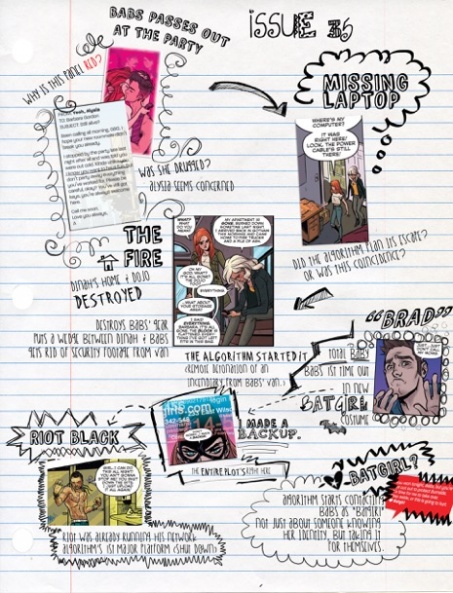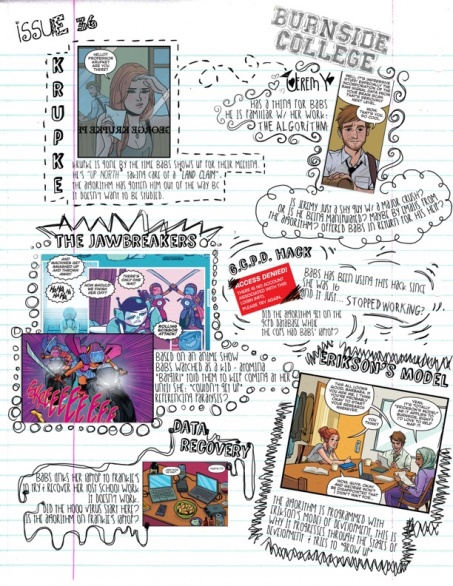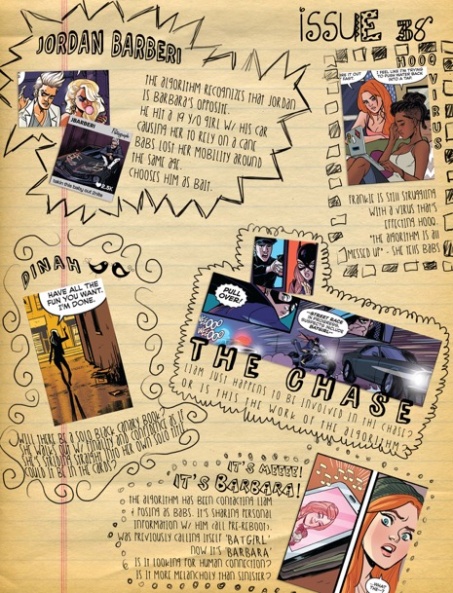
Since October, Will and I have been posting monthly discussion about “Batgirl”. We decided that we should take some time and look at what has happened in the arc so far, and make some educated guesses about what might happen next.
Sam LeBas: Well, we have a new theory about Batgirl.
Will Brooker: Right. We don’t usually do this, mid-month. We would wait until next issue.
SL: But after the Truman Show theory you put forward last time, I feel we owe people.
WB: That was a bluff.
SL: And this one is not, correct?
WB: This one, I am staking your reputation on it.
SL: Not much to lose then. Go ahead, start us off.
WB: At the start of #36, Babs tells Jeremy that she developed an algorithm while she was in recovery, a few years ago. From the start of #35, we know that the recovery period was about 3 years ago, when she met Frankie in physio. From her conversation with Jeremy at the start of #36 and the scene with Nadimah in 38, we know that the algorithm drew directly on Barbara’s mind.
We also know that every ‘villain’ Babs has faced in Burnside has been, in some way, an echo or mirror of an aspect of her: Riot Black has her digital networking skills and uncanny memory. The Jawbreakers are inspired by an anime she watched as a kid. Dagger dresses as Batgirl and his photography exhibition includes a portrait of her in a wheelchair, and Jordan Barbieri’s name reverses hers – he is also guilty of seriously injuring a young woman and leaving her with a disability that leads her to walk with a cane.
The algorithm went missing when Babs’ laptop was stolen at the party in #35, and the solicit for 40 tells us that ‘A decision Barbara made during her darkest days in Gotham City returns to haunt her!’
So, given that, here’s the theory. Are you ready?
SL: I was born ready.
WB: When Barbara was recovering from the injuries she sustained at the hands of the Joker — because we know that the events of The Killing Joke still happened in the New 52, albeit with some changes as it’s depicted in Gail’s run — she was spending a lot of time in hospital, depressed and traumatized. Her spine was seriously injured. She couldn’t walk. She was living in her head, centered in her mind. During this period, she created a back-up of her mind. This is the algorithm.
It knows her family past, her trauma, her experiences with Joker. She created it when she was in a very dark place, perhaps because she realized how fragile and breakable her body was, and wanted to back up the one thing she had left.
The algorithm continued to interact with her during the next three years.
It knows, and in a way experienced, what happened with James Jr, Alysia, Barbara Sr., Jim and the Joker during Gail’s issues. The algorithm feeds on her experiences and feeds them back to her. They are in a dynamic. They are, in a way, symbiotic. Throughout her recovery and throughout Gail’s run, we know that Babs made extensive use of digital networks and electronic communication. The algorithm on her system – on her laptop and presumably her other computers – was interacting in that process. It was her partner. During this period, somehow, it became independently sentient. When Babs decided to move to Burnside to pursue her postgraduate studies, the algorithm experienced a kind of resentment. It enjoyed the dynamic in Gotham, a place of pain… a dark, haunted place where Babs couldn’t ever escape her memories, as Gail’s run showed us.
The reboot in 35 is a new start. A new career in a new town.

The algorithm, inasmuch as it can think and feel, doesn’t want Babs to start again, to change and be happier. It wants to retain the dynamic of mutual trauma and depression it had before. It feels it’s going to be left behind, in this new life of hipsters, cute guys, fresh bands and coffee shops.
Continued belowSo, it defends itself.
We can’t know this for sure, but it is quite possible that the algorithm, knowing full well Babs was moving to Burnside to live with Frankie, because it reads all her social media and emails, reached out to Riot Black and alerted him about the housewarming party, with so much opportunity for theft.
Or possibly, the theft was a coincidence. That doesn’t change what happened. Riot Black sent his man, ‘Brad’, to the party anyway.
SL: So essentially that’s its escape.
WB: Whether it was planned or coincidence, that is when the algorithm escapes. It jumps ship from Babs’ network onto the larger, Burnside-wide Riot Black network. And at this point I want to introduce a new name for the algorithm. Essentially it is the answer to whether Babs was ever Oracle in the New 52.
The algorithm is the New 52 equivalent of Oracle. It is Babs’ mind on a computer network.
And in this continuity, it has become a resentful digital sibling, jealous of Babs’ move to Burnside and determined to sabotage her. This is where the story starts.
Before we go on to examine the details of how exactly Oracle/The Algorithm responds to Babs’ new life in Burnside, there’s one other piece of information that is absolutely key to understanding this story arc. It’s mentioned briefly at the end of issue #36, but it is crucial.
Nadimah says the algorithm is Erikson’s model as applied to Burnside. In fact she says Erickson, but we will assume this is a typo. Erikson’s model of social development tracks various stages of an individual’s progress through society, in relation to him or herself, to parents, friends, role models and romantic partners.
If we assume that the algorithm is effectively ‘born’ when it escapes from its ‘mother’, Babs, it then goes through the stages perfectly, as reflected by the people it chooses as its tools to sabotage Babs’ life.
See the chart below for more details, but here’s the essential pattern.
It starts as an infant, and it’s engaging with ‘Brad’, the petty hardware thief, who has his own identity problems (multiple false names) and who regresses into a baby when he’s cornered, begging Babs ‘don’t tell my moms.’
The next person it sends against Babs is Riot Black, who has the rampaging, selfish ego of a toddler.
It’s no coincidence that Riot strips half-naked, like a little kid, and that they duel in a men’s bathroom. This stage of development involves toilet training – and this is even cued on page 2 with the sound of a flush.
In #36, the algorithm sends the Jawbreakers against Babs. It’s chosen them because they’re cosplayers – identity issues and costumes again – of an anime she watched with her dad when she was seven years old. This stage of Erikson’s model concerns family and the use of tools, or toys – like bikes and an Atomina model.

The controversial Dagger Type issue, #37, corresponds to the Competence stage. Inferiority versus Industry – represented by Dagger’s drive to make it as a celebrity and connect with Kanye.
SL: In #38 we have Jordan, who is complicated, I think the algorithm seeks him out because it’s looking for a mirror to confirm its role. Jordan is literally that mirror. His name is the reverse of Babs’, his father is a criminal while Babs’ is police commissioner. This also fits with the stage of identity vs role confusion. Jordan is preoccupied with the way that he is seen by others, and uses the public to reflect his image back to him. Like Babs at this point, he wants to be ‘likable’.
WB: Issue #38 focuses on the next stage, characterized by romantic relationships – as the algorithm attempts to engage with Liam.
So. In issues #39-40 we have two more stages to go through. We know there’s going to be a Hooq party, and that it’s likely Hooq will be taken over by a big player. The Hooq party will, we believe, be the big social focus of #39. At the end of that issue, Babs will find out who the villain is — the algorithm — and then the Secret Origins issue following that takes us back in time to explain the backstory, bridging us to #40.
Continued belowThe algorithm, which is currently in the Hooq code creating false matches and messing with Frankie, wants to jump ship to a larger network. This will be its opportunity. We know from #36, when it gave half a million to the Jawbreakers, and also from #37, when presumably it funded Dagger’s exhibition and costumes, that it has access to major finances. We believe the algorithm is orchestrating the takeover of Hooq.
It wants to enter the wider world outside Burnside, which is what it’s now occupying through a beta, local social app. I think this probably ties in with the next Erikson stage, generativity vs stagnation. In effect, perhaps it wants to breed. It’s been seen as a virus within Hooq. This stage is about ‘parenthood’ and making your life count. To an algorithm, I can only think this means spreading more widely. In any case, this issue will see, as the cover confirms, Batgirl vs Burnside. The algorithm will turn her existing relationships and the community she’s cultivated as a local celebrity against her.
At the end of #39, she realizes who or what it is.
Now, Erikson’s model suggests an interesting conclusion in 40. The final stage, which the algorithm with its speeded-up lifespan will be entering in 40, is Ego Integrity vs. Despair, Wisdom. This stages addresses relationships between an individual and ‘Mankind, My Kind’, and the existential question that frames this stage is: Is It Okay To Have Been Me?
During this Reflection on Life phase, the algorithm will, I suggest, reach a phase of melancholic realization and self-reflection. It wanted to be independent and alive. I think it may realize the damage it’s caused and sabotage itself, but then it may well be rehabilitated by Babs and Q, rebooted, renewed. A really neat ending to #40 would be that the algorithm is back online, but as a helper and digital assistant.
And just for an idea, what if Q announces, on the last page: ‘I’ve named it after a figure I read about in Greek mythology: ORACLE.’ Boom. Final frame.
Big reveal, a neat conclusion. This may not be the exact case, of course, but we suggest it’s a nice one.

SL: So, as the algorithm is progressing through the stages of development. Barbara is regressing. She starts the arc with a ton of baggage, or more generously, wisdom.
She’s got to let go of all that to be effectively rebooted, or reborn.
We have to see her fail each of the tasks that normally mark the completion of each stage. At the beginning of Issue #35 she’s leaving Burnside, and her story starts with a goodbye.
Then in that same issue, she fails to be a good caregiver. She doesn’t comfort Dinah when she’s upset, doesn’t manage to make it back to the apartment with coffee. Doesn’t provide a safe environment for the algorithm.
Then in #36, she meets Jeremy, and they seem to hit it off, but she makes no attempt to have a relationship. That’s Babs regressing through the love stage. She also confronts the Jawbreakers, who force her to lose her sense of self security and move her backward through the fidelity stage.
In #37, with Dagger, she and the villain are on the same page but represent different directions. He is trying to build a reputation while she is being forced to defend hers.

Issue #38 shows Babs failing the Purpose stage. She is in motion purely for the sake of being in motion, going after Jordan when others warn her against it. She disrupts other people’s plans, going into Q’s house uninvited. She also seems to have no understanding of danger or consequence, as Liam points out at multiple times during this issue. That relates to the second stage, Will.
I think in the next issue, she will be rendered helpless, and need to rely on others, bringing her back to the first stage, hope. So, in 40, we will have the new Batgirl/Babs, who has truly started fresh and finally been born again.
Continued belowNow there is something else you wanted to address, isn’t there?
WB: There is, actually Sam.
On another level, this arc is about something else, as I’ve raised in our previous HOOQ-Up conversations. It’s about continuity and reboots.
It’s about the way, just as you can’t simply run away from trauma and memories, you can’t simply reboot a character and dump the previous writer’s arc. On one hand, the creative team did want a fresh start for Babs, with a new editorial.
On the other, they respected and appreciated Gail Simone’s work, and they knew fans would remember those previous 34 issues, when Babs went through a lot of dark character arcs. You can’t just pretend that didn’t happen. (Unless you reboot the entire continuity, but this was a soft reboot).
Just as, in Morrison’s Animal Man, there are characters who remember the previous continuity, so this storyline is on one level about Babs dealing with the Gotham stuff, the family dramas, that she went through under Gail. Dinah is one link to that. So is Alysia, There’s a very self conscious, meta scene in #38 where Dinah is accusing Babs of running away and becoming more infantile, ditching her past life.
But to move on, you have to process what’s gone before.
That’s true on a character level and it’s true on the industry level of being a creative team taking over from a very successful, popular writer and her artists. They could have just ditched Gail’s stuff. But I think they did something more generous and ethical. They didn’t pretend it never happened. They show us Babs trying to pretend it never happened, and failing. They show it coming back, in the form of the algorithm, to remind her of that past.
And by issue #40, whose cover features the rebooted costume and the older costume of Gail’s run, I think she will have processed the trauma of issues 1-34, and genuinely be ready to move on.
SL: This is an incredibly complex Batgirl story.
WB: For a book that was meant to be lighthearted and fun, this is an incredibly ambitious story.
And I think it bears really detailed examination and discussion, which is what we’ve been doing over the last five months. It feels like we’ve lived with Batgirl and gone through this with her.
SL: We have, and you’re still my favorite person to talk about Batgirl with. Though, a close second this month was, Jay Threadbear.







